Wednesday, November 18, 2009
The Place: The MUST
Tuesday, November 17, 2009
Tasting Notes: Chappellet 2007 Mountain Cuvee
Chappellet is a Napa winery growing in Pritchard Hill, making large, Bordeaux-style wines of the type we tasted tonight. The Mountain Cuvee is a heavy, juicy wine that is sweet around the edges, though the lighter berry flavors don't take away from its darker notes. It went perfectly with the rich sauces, sides, and red meat dishes being shared at the table. What was unique - described by one of our dinner companions as "offbeat" - was a eucalyptus / minty finish (as described by Joseph). While I haven't played koala recently, I absolutely knew what he meant after my first taste, and wholly enjoyed the effect. I would describe it as a slightly woodsy-herbal finish that leaves your palate feeling dry but refreshed. For me, this twist distinguished the wine from the other tried and true Bordeaux and Meritage wines that are so popular at these big, steak dinners.
At $29 off of the winery's online shop, I'd call it a great value; some other searching turned up alleged $25 price tags.
A brief side note: My one complaint was that the wine list stated a 2006 Chappellet; the manager explained that they only carried 2007, and their wine list must not have been updated. Clearly enjoyed the wine anyhow, and the year was not an issue in this particular case, but would have appreciated a heads-up upfront. Word to the wise, however, to remember to double check the label, esp if it is a situation in which the vintage year makes a difference.
---
BOA
9200 Sunset Blvd
West Hollywood
Tasted: Chappellet 2007 Mountain Cuvee (Meritage)
Cabernet Sauvignon / Merlot / Malbec / Cabernet Franc / Petit Verdot
Thursday, November 5, 2009
In a pinch...
Bottle uncorked with a shoe
Monday, October 26, 2009
Tasting Notes: 2005 Kalyra MC2 Santa Ynez Valley
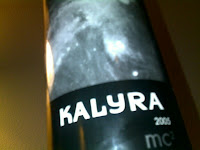 Finally had my first proper wine night in the new apartment on the beach, and a long overdue catch-up with LL was more than enough reason to pull the cork on this wine that has been sitting on the rack for a couple months now. The science nerd in me was drawn to the bottle by the black and white Hubble telescope image of the universe, but the wine nerd in me had to bring it home because of the wine's smooth drinkability.
Finally had my first proper wine night in the new apartment on the beach, and a long overdue catch-up with LL was more than enough reason to pull the cork on this wine that has been sitting on the rack for a couple months now. The science nerd in me was drawn to the bottle by the black and white Hubble telescope image of the universe, but the wine nerd in me had to bring it home because of the wine's smooth drinkability.Yes, Kalyra was a Sideways winery, but it is a Santa Ynez gem and favorite among many of my other wine-drinking friends in the Southland. The winery was started by an Australian who made his way over to Santa Barbara, and they have made some pretty interesting wines that are imbued with the label's offbeat spirit. MC2 is a Merlot blend, mixed with some Cabernet Sauvignon and Franc in the Bordeaux style.
These are not wines that will shock your senses, but rather more subtle in their impressiveness. MC2 is at first a soft red that opens up into a creamy, almost velvety wine. The dominant Merlot lends it a fruity sweetness (as far as reds go), but it is a fairly deep wine with a good balance of light tannins. The dark fruit flavors nicely complemented our garlicky hummus snacks, with a bit of chocolate raspberry when it sits full in the mouth. A good value, and an interesting twist on a fairly standard blend.
---
Kalyra Winery
343 N. Refugio Rd.
Santa Ynez
(805) 693-8864
Label Notes: "Moving at 5 miles per second The Hubble Space Telescope has orbited the Earth 100,000 times (and counting) traveling over 4.8 Billion Kilometers since being put in Space 18 years ago. [sic]"
Wednesday, October 14, 2009
Tasting Notes: Working Late @ Father's Office
First and foremost, however, Father's Office is not a restaurant but a bar - someone is checking ID at all times, even at 1 pm on a Sunday. They have a vast, changing, and well-selected array of beers bottled and on-tap, but they also pour some good wines, with a fair representation of Santa Barbara producers. Should you be in Culver City or Santa Monica, definitely pop in, get some fries, and savor them once you've staked out a table (gets pretty competitive, especially at the smaller, original location in Santa Monica).
2006 Paige 23 Pinot Noir San Luis Obispo
Described in the tasting notes as having flavors of plum, cherry, and smoky raspberry, this wine was a full and fun pinot noir that had hit you pretty hard in the nose. It was soft and creamy on the palate. Though I can't say I'd call it smoky raspberry, I see the inspiration; the Paige was a full of those dark, fruity flavors and actually had a soft finish.
2006 Poderi dal Nespoli Sangiovese di Romagna
I was ready for something bigger, and this sangiovese fit the bill. It was still an easy accompaniment for some light conversation, but also had a bit of spice and tannins that complemented the heavy Indian flavors from my lamb skewers. Both good wines that I'd come back to.
---
Father's Office
1018 Montana Ave
Santa Monica, CA
(kitchen closes 11pm Thurs - Sat,
Sunday, October 4, 2009
sweet noble rot
Rotting, moldy things are typically to be avoided, e.g. berries, leftovers, roadkill. This got me thinking, however, as I turned to the next closest thing (my wine rack). Noble rot is key to the syrupy sweetness that makes the popular (and pricey) dessert wines of Sauternes and Hungary so prized. I really had no idea of how noble rot works or its role in the vinification process, so I took a break from tasting anything this weekend (thanks a lot, first cold of the season) and dug around in my wine encyclopedia. And online. After all, if it's on the internet, it must be true.

What happens as the botrytis spores grow is key to the concentrated sweetness and high alcohol content that define these wines. The spores feed off of the grape's extra moisture, concentrating the remaining juice into a thick and sugary mix. Because botrytized grapes are typically harvested one-by-one, the making of wine from these harvests is highly labor intensive. Once the grapes are harvested and used to make wine, the sugar content promotes alcohol creation in the fermentation process. The results are the heavenly (yes, really) Sauternes and aszu wines, as well as some lesser known German and Italian styles.
I won't get into detail on these wines now, but I do suddenly have a craving for a glass and some accompanying dessert...
---
Tasted: Chateau Rieussec
To Taste: Chateau d'Yquem (should you be so lucky)
How Noble Rot Produces Sweet Wine
Sauternes Vintage Chart
Profile on Chateau d'Yquem
Hungary Returns to a Sweet Past
photo: Hans Voorn via flickr
Saturday, September 19, 2009
Tasting Notes: 2006 Melville Sta. Rita Hills Syrah, "Donna's"
The wine is a powerful blend of sweet, dark fruit and a lingering, pop-rock-like pepper finish that bursts across your taste buds. In the glass, it is a rich and inky, deep purple color. At first, I tasted more of blackberries & cassis, but as the wine had more time to sit, the acidity softened out somewhat and I tasted more of the earthy undertones mixed in with the fully expressed fruit flavors. Melville's tasting notes suggest it might be "sinister," I'd almost call it "lascivious;" the creaminess seduces the palate before that kicky finish teases you to take another sip - I'd even say the peppery borders on overwhelming, so this is not a wine for the faint-hearted. Certainly a delicious syrah with a shamelessly bold personality. Probably good to drink now and for another two years, at least. Enjoy.
---
Tasted: 2006 Melville Syrah "Donna's"
Thursday, September 17, 2009
bikes & flights

Santa Barbara wine country is a charmed area for multiple reasons in addition to its obvious draw as an epicenter for delicious, mouth-filling pinot noirs - from the established wineries along the Sideways wine-tasting routes to smaller, family operations, every vacant plot of sloping hillside is gradually filling with new wines to discover.
Over Labor Day weekend (yes, I'm a little behind on the updates), I took a trip up to Zaca Lake, a retreat also known as the location set for warm and fuzzy movies like the Creature from the Black Lagoon and Friday the 13th, part 3. We arrived at the gate just before midnight, learning something about what it means to be in complete, pitch-black darkness. After struggling with the padlock, we bumped over 5 miles of rough, narrow and winding road, traversing a couple of small, mostly dry creek beds and giving A, my backseat passenger, some mild car-sickness.
We woke up to find ourselves nestled between mountains on all sides, having stayed in the cabin above with 20 other strangers who would become our friends by the end of the weekend. We had all driven up variously with bikes loaded onto the backs of our cars, training for races the next week but eager to combine some pre-taper workouts with wine-tasting and outdoors relaxation over the long weekend.
I've been in the area several times for both tasting and cycling, and can't get over what a great place it is for both. The Solvang Century, held annually in early spring, was my first century ever and so beautiful, with one of the aid stations housed in a lot adjoining Fess Parker, at about mile 90 and just before the final (killer) hill on the road toward Los Olivos. This time, all 20+ of us drove our bikes from Zaca Lake to Los Olivos for a good long ride, combined with some tasting...and then disaster struck.
My tire had a pretty little hole in it from a ride earlier the day before, but figuring it would be a quick fix, I left it until we unloaded the bikes in Los Olivos. In a series of bizarre mishaps, we struggled for about 30 mins before realizing the poor wheel just had to be taken to a bike shop. I'd basically resigned myself to missing out on a great ride AND a full day of tasting, but A and I rolled into Dr. J's in Solvang where the friendly shop guys not only fixed my tire pronto, but a laid-back local hanging outside led us on a nice, 20-mile jaunt on the mostly flat roads around Solvang and Los Olivos. You can bet I'll drop back by there next time I'm in town, whether just to say hi or to find an excuse to buy something new for the cycling habit - they're the kind of local bike shop you want to have in every neighborhood. We were back in time for a late lunch at Panino before popping back into Los Olivos to try and reconvene with our fellow cyclists.
Los Olivos always becomes a bit of a mad house on the weekends, with the main square overrun by limousines and black cars chauffeuring groups around to tastings and a flood of other weekend visitors stopping in for a mid-day break from tasting. It's never so crowded that it takes away from the charm, however, and Saturday was no exception. I saw some riddling-rack wine holders for sale that I've added to my mental checklist of items for a future house, and A successfully procured various locally grown gourmet garlic varieties to save for future cooking endeavors.
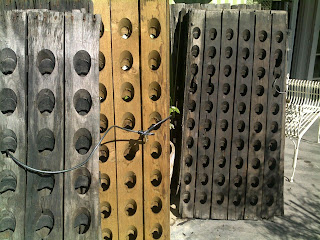
There are numerous tasting rooms all over Main Street, which I've found to be hit or miss. The winery specific ones are generally better, and Saarloos&Sons was a pleasant discovery this time around. They fall into the family-run category, with Keith Saarloos pouring. He had this great trick of pouring just enough into the glass, then rolling the glass across the counter on its side, without spilling a drop. I've made a note to practice with some cheap wine and master as a future party trick. I guess I could also try learning to tie a knot in a cherry stem, but back to the wines -
They mostly grow grapes used by other wineries, but started producing small quantities of their own wines. Of the ones we tasted, I most enjoyed Daughter's and 194Five The Union. Daughter's is a fresh, sweet Chardonnay blended according to the tastes of the women in the family. I thought it was refreshingly different from most California Chardonnays I've tasted, with a soft and slightly creamy feel and light, fruity flavors that rush the palate before fading away like the champagne fireworks you see on the 4th of July. 194Five The Union is a Syrah-Cabernet blend that is a strong, masculine contrast to Daughter's, with its dark and smoky flavors and tannic finish.
This was unfortunately the only tasting we had the chance to breeze through, despite an ambitious schedule, but I'll likely be making another tasting trip in the next couple of months, with more to come at that point on some of my favorite wineries and tasting routes.

Tuesday, August 25, 2009
L.A. Sommeliers and Chefs Toss Back Summer Beers
from eat:LA
L.A. Sommeliers and Chefs Toss Back Summer Beers
Thursday, August 20, 2009
Color me organic
A couple of years ago, my then-roommates and I were in the habit of having friends over to our modest (tiny) space once or twice a month, over 6 or so bottles of wine and conversations that grew increasingly silly as the glasses emptied. Though these were meant to be beginning-of-the-night stops, they more-often-than-not ended with several of us curled up on the floor cushions with no desire to pursue any further bar-hopping or other exciting social engagements.
One such night I was able to convince the roommates it would be a good idea to do only organic wines; everything else is going green, why not go green with the wine, too? And so I asked for some favorite picks at the store, came back with the standard collection of a half-dozen bottles, and excitedly served them up.
What exactly makes a wine organic? Well, just as with foods at the supermarket, there are certifying bodies, but the term is not a clear-cut indication as to how a wine is produced. A wine "made from organically grown grapes" may not necessarily be an "organic wine," and must be labeled accordingly. The difference here is simply because an "organic wine" can have no sulfur added during winemaking process, a step that aids in the aging of wine as it reacts with oxygen in the bottle to prevent the wine from oxidizing before the cork has been removed. Those with sulfite sensitivities (like one of my old roommates) may prefer organic wines for this reason.
By the time we had worked our way up to the fourth bottle of the evening, one of our friends took a sip, and remarked that it "tasted like green earth." Organic wines are sometimes criticized for relying on the certification as a marketing gimmick while sacrificing the integrity of bottles produced. Of the organic wines I've tasted, at this particular tasting and since, I would have to agree that there is a whole range of quality to be found amongst the organic wines. There's no specific advantage, taste-wise, for choosing an organic wine over one otherwise labeled. Even with concern over production practices though, it may not be a meaningful difference as all quality grape growers should be focused on practices that extend the life of their soil. Most of the agricultural methods employed to create prime growing conditions are already fairly sustainable.
What makes the whole business even more confusing is the parallel growth in popularity of biodynamic wines. These merit a post of their own. In summary, biodynamic wines are similar to organic wines in production methods but employ an even more holistic, philosophical approach to growing - preparations involve burying cow manure in horns or adding wildflowers to compost that is spread on the vineyards. My brief take on both? Organic and biodynamic wines are best for those who are primarily concerned with the many steps to winemaking that occur before grapes are even harvested.
---
Tasted: 2008 Sauvignon Blanc, Mauritson, Dry Creek
More on certification:
California Certified Organic Farmers
Sunday, August 16, 2009
windy city wining & dining
I can't tell you how many times I've flown through Chicago's airport, rushing through the concourses to catch a connecting flight, never curious about the city beyond or pausing for long enough to think whether I'd even want to stay a little longer. Over the last couple of years, however, it seems like every friend of mine I've talked to has loved the place, so okay - I got a little curious, and finally dropped in for a weekend.
In addition to doing the essential touristy things - walking the Magnificent Mile, grabbing some great (really yummy) pizza, hitting the beaches on Lake Michigan, Millennium / Grant / Lincoln Parks, an architecture boat tour, etc. - the highlight of the weekend was dinner at Alinea. I've been fantasizing about eating here since I saw this slideshow from a dinner hosted by Grant Achatz and Thomas Keller, Achatz's old boss at French Laundry, so could hardly wait for our Saturday night dinner reservation. There's no use in pretending I'm a food blogger, but at a place like this, the wine is at best a complementary element to an amazing meal.
Alinea's food emphasizes the intense and varied flavors contributed by each element of a dish, and Achatz has established himself as a leader in molecular gastronomy (alongside Ferran Adria of El Bulli, of course). Prior to dining at Alinea, my only real encounters as an experimental gourmand were at New York's WD-50 and Bazaar, LA's trendy restaurant-of-the-moment. I enjoyed the meals I've had at both, enough to have dined at Bazaar on multiple occasions, but Alinea put both to shame in all categories - inventiveness, presentation, ambience, pure deliciousness...
Dining at Alinea was a lot of fun. We had snagged a reservation on the earlier side, with the upshot being that each dish was a surprise, unspoilt by having seen it previously presented to any of our fellow diners. The highlights were a decorative vase spewing smoky fumes of peppery steak on a grill, dessert served on self-deflating pillows wafting lavender air, and a fascinating tobacco ice cream.
Though we opted for two half-bottles, it seems a wine pairing would be the way to go with better planning (we had numerous additional stops to make after dinner that would have been more difficult to navigate after so many glasses of wine). The sommelier was helpful in picking half-bottles of white and red that would pair appropriately with the mixed bag of dishes we were to experience, leading us to an Austrian Riesling and a Rhone.
The three of us at dinner are all big red drinkers, though R has more experience with whites and, despite being hesitant (ok, actively against) Riesling, we were convinced to give it a try. As promised, the Riesling (note to self: be better about recording names of wines tasted) was nice and dry, more like a Sauvignon blanc than the overly frilly Rieslings with which most of us are acquainted. The Rhone was a 2004 Domaine de la Solitude Chateauneuf-du-Pape, which drank well with the Wagyu steak and rich flavors dominating the later half of our dinner courses.
The wine really took a backstage to the food here - which is what good wine should do, when paired with excellent cuisine (though we did come away newly open to Austrian Rieslings). Ideally, wine should enhance what is on the plate, bringing out subtle or missed flavors and enhancing the full expression of more dominant ones. For us at this meal, however, it was all about the fun of being in Achatz's hands.
---
Alinea
1723 N. Halsted
Chicago
312-867-0110
Achatz's writings for The Atlantic
photos: thanks, Jessisah
Thursday, August 13, 2009
Wine that travels well
FASHION & STYLE
Physical Culture Gear Test, Wine Chillers
Michael Brands for The New York Times
Published: 20090812
When it comes to summertime relaxation, the idea of an outdoor picnic — complete with a nice bottle of wine — is hard to beat. One of the hardest tricks to pull off, however, is keeping the wine chilled along the way.
http://www.nytimes.com/slideshow/2009/08/12/fashion/20090813-physical-slideshow_index.html
Monday, August 10, 2009
Varietold: White zin your pocket? (say it fast)
Zinfandel is a versatile grape that makes for some interesting red wines, but the white zinfandel take carries none of the expected peppery, bodied notes and is rather a light, fruity and almost punchy wine. These carefree qualities make it an easy wine to drink, clear and refreshing in contrast to the heat of the grille. So, even though I'm not here to extol the undiscovered epiphanies to be found in that blush, I would advocate at least picking up one bottle this summer and giving it a try.
---
Tasted: Beringer White Zinfandel 2007
Tuesday, July 28, 2009
Bowl'ed Over
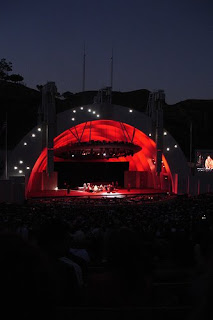 In what became a whirlwind weekend of enjoying summer outdoors, I had the good fortune of snagging tickets to Dengue Fever / Of Montreal / Grace Jones at the Hollywood Bowl with E, my partner in exploring the many great concerts always going on around town. First of all, let me go on a small tangent in saying that I love all three acts, so do check out their music if you're not familiar. Secondly, Grace Jones is one fierce woman. She changed costumes every song (some images here), each more outrageous than the previous. And I am definitely getting her album. Seriously - is this woman really 61? I can only hope to age so well.
In what became a whirlwind weekend of enjoying summer outdoors, I had the good fortune of snagging tickets to Dengue Fever / Of Montreal / Grace Jones at the Hollywood Bowl with E, my partner in exploring the many great concerts always going on around town. First of all, let me go on a small tangent in saying that I love all three acts, so do check out their music if you're not familiar. Secondly, Grace Jones is one fierce woman. She changed costumes every song (some images here), each more outrageous than the previous. And I am definitely getting her album. Seriously - is this woman really 61? I can only hope to age so well.But back to the topic at hand. The Hollywood Bowl is one of my favorite places in LA, consistently listed as one of the best outdoor music venues, and such a great place to spend a summer evening. As with the Getty and Barnsdall Fridays, it mixes great music with a relaxed atmosphere and B.Y.O. spirit. Bench tickets are usually in the neighborhood of $30 or less, even with Ticketmaster fees tacked on. Pack a picnic, bring a bottle of wine, and enjoy a great show. Perfect.
My one major tip will be on parking/traffic. I've found Franklin to be a good way to get around going east/west. There are free shuttles from Griffith Park and other locations around LA. I generally avoid the Bowl lots as much as possible since it's stacked parking; instead, park at Hollywood & Highland, grab a bottled water and get validation for $2 parking (fine, so maybe $4 including the water), and walk up the hill to the Bowl.
Concerts with fireworks make the night even more fun. Remaining shows really span everything; my goal is to try and catch one of the LA Phil shows before the season ends.
---
The Hollywood Bowl
2301 N. Highland Ave.
for schedule, tickets, directions:
http://www.hollywoodbowl.com/
LA Weekly Review
photo: Omar Omar via flickr
Sunday, July 26, 2009
T.G.I.(Barnsdall)F.
Consider this the second installment in a series exploring LA's outdoor drinking/picnicking possibilities, picking up where I left you at the Getty:
Last Friday afternoon, I climbed the steps from
The atmosphere feels like you’ve crashed a fabulously cool backyard party, where you’re welcomed like an old friend, thanks to a laid back and unpretentious vibe: Picnic blankets dot the grassy hilltop, sartorially prescient hipsters mingle amongst strollers and playing children, and a just-right soundtrack rounds out the setting. It doesn’t hurt that the hilltop location offers up unobstructed views of the
In case you forgot to pack your own food, the Let’s Be Frank and Coolhaus trucks are also in residence, perfectly in step with (and perpetuating) the Angeleno craze for mobile food.
The tastings have become increasingly popular since they started in May, thus it's advisable to order tickets online (it saves you $5!) [edit: tickets are now sold only in advance, details below] and show up on time to avoid long lines for the (generous) pours // stake out a good picnic spot. Tours of Frank Lloyd Wright's Hollyhock House can also be reserved for $8 per person; later tours sell out by mid-week. Word is that movie screenings will start after Labor Day, and tastings will continue until it’s too cold – in LA, does that mean when it dips below 60?
---
Barnsdall Art Park & Silverlake Wine
Barnsdall Fridays
5:30 - 7:30 p.m.
4800 Hollywood Boulevard
tickets online here
$15 until midnight Thursday
$20 until 4:30 p.m. Friday
Shanghai Dispatch
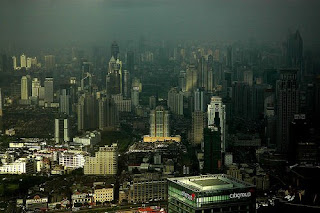
I've got a bit of a backlog but had to make sure and fill in some notes from a recent trip to Shanghai that involved some oenological adventures over dinners at Jade on 36 at the Shangri-La and Jean Georges's Shanghai outpost. Both restaurants had killer views of Shanghai - Jade on 36 has a high up view on the Bund's historical trade buildings, while Jean Georges offers up the perspective from the opposite bank, nicely framing up Pudong's space-age skyline.
Chinese wine unfortunately doesn't offer much to explore, at least not yet (and likely not for 5-10 more years); when I mentioned wanting to try some Chinese wine this trip, a few of my friends threw out Great Wall in the manner of a four-letter word. While Chinese rice wines and beers are popular and enjoyable, grape wine made in the European style has only recently become more popular due to China's ascendant middle class and its accompanying taste for European and Western imports. Chinese winemaking dates back thousands of years, with the first vines planted in 128BC. But these dates really mean nothing as modern Chinese winemaking is still very much a fledgling affair: There are no regulations to standardize labeling with regard to varietal, appellation, or vintage. Government regulation with regard to import tarriffs, approval of joint ventures with foreign winemakers, and control of distribution is constantly in flux.
Yet there is opportunity for development as Chinese winemakers trained in Europe have become more active, and foreign investmenthas grown with higher-profile projects including a joint venture from Remy Martin (Dynasty), partnership with Torres (Grace), plus greater interest from winemakers around the world. Many Chinese domestic wine producers are either state-owned enterprises or cooperatives, largely centered in the coastal Shandong Province with some wines coming out of Shanxi Province, futher inland along the same latitude. Even if China is not the next great terroir, the potential market represented by the sheer size of its population continues to tempt further investment in developing a robust Chinese wine production center.

Dinner in Shanghai was a constant struggle for me during the whole week there, as I found myself fighting jet lag (usually unsuccessfully). The first relevant meal at Jade on 36 was pretty standard French fare with a somewhat modern spin, appropriately paired with a Louis Jadot Nuits St. George. I wish I could say I had written down notes on the first impressions, but I do remember it was a somewhat fruity yet acidic wine. It was also the first Burgundy I'd had in a while, and an interesting contrast to the fruit-bomb flavors I've come to expect from Santa Barbara pinot noirs. A thanks to D for the meal, and J for the pictures here and below, and both for being good dinner company.
A couple of nights later, we had the good fortune to dine at Jean Georges (certainly can't complain about the food on this trip!), where the sommelier was a bit of a character, and nice enough to chat with us about Chinese wine (didn't seem that excited) as well as offer up a taste of some Grace Vineyard Merlot. We all agreed that the wine teased the palate with promising Merlot characteristics, it was ultimately a one-dimensional wine that faded quickly. To be fair, however, he did say that the white wines were much more satisfying; for whatever reason, that savoir-faire has yet to filter into the red wine production.
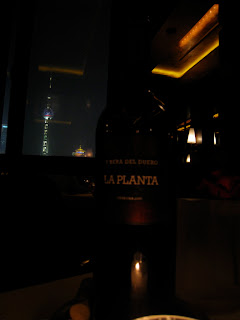
We spent the rest of the meal contemplating a tempranillo from Ribera del Duero in Spain, pictured above with the Pearl Tower in the background. It had all the full-bodied characteristics you would expect from a tempranillo of its provenance, plus strong flavors of dark fruit and a heavy earthiness I could only describe as "loamy." This bottle was much more interesting over the course of the dinner, with different flavors emerging as we let it breathe further.
All in all, a great trip to Shanghai. I am undeterred in my search for a great Chinese wine, despite the signs that its time has yet to come. If anything, however, this trip has made me aware of the wide variety of winemakers that are out there; the only challenge will be in finding a quality one, then lugging a few cases back across the Pacific.
---
The Angle of Light, pmorgan via flickr
Friday, July 17, 2009
Simple Sangria

White Sangria
serves 10-12
2 bottles white wine (pinot grigio, sauvignon blanc, or cava/moscato for sparkling)
2 white peaches
1 pear
1/2 orange
1 cup blueberries
1 stick cinnamon
Red Sangria
serves 10 - 12
2 bottles red wine (merlot, zinfandel, syrah)
1 apple
1 - 2 cups strawberries
1/2 orange
1 lemon
Preparation:
For both recipes, cut fruit into slices or sections as desired, combine in large bowl or pitcher. Pour wine over fruit, and let sit for at least 3 hours, but ideally overnight. Add 1 - 2 tbsp sugar to sweeten and help release the fruit juices. Additionally, feel free to add any combination of brandy, orange juice or club soda to add some fizziness or adjust the flavor. Club soda should be added immediately before serving.
---
photo: byrdiegyrl via flickr
Tuesday, July 14, 2009
Varietold: My Fair Carmenere
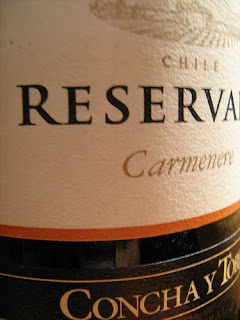
There would be no Imperial or cacique that night; no, we'd move on from the US$1 bottles and really splurge. It was a carmenere from Casillero del Diablo, part of the family of wines produced by Concha y Toro, and which has since worked its way back into my life on more than a few occasions - particularly given that it can usually be found for about $7.
A smoky but easy-drinking red, this carmenere had just enough spiciness to complement a meaty entree, and sparked my interest in the grape. Carmenere has become almost synonymous with Chilean wine as the region's producers have planted and produced it in ever-greater quantities over the last decade. Despite its developing status as a hallmark of New World wines, however, carmenere actually traces its roots to Bordeaux. It was thought to have been rendered extinct until it was found growing in Chile, mistaken for Merlot.
In almost any carmenere you taste, certain traits will be exhibited to varying degrees of clarity, like hints of spice and fruit, usually balanced out with a rougher finish that lingers on the tongue. It is still a wine that is very much in search of an identity, however, as the Chilean producers continue experimenting with winemaking styles and with different blends - softening it up with Merlot, or creating more full-bodied wines with Cabernet. Critics' opinions vary on its viability as a "signature" varietal for Chilean wine, but carmenere will only become more interesting as winemakers become more fluent in manipulating its flavors. Already, even newer winemaking regions have begun picking up on the grape, hoping it will lend their wines a unique edge. It remains a great value, and an interesting addition to one's red wine flavor spectrum.
Even five years on, each taste takes me back to that indelible first meeting. The electricity went out about half way through dinner, leaving us dining in near darkness, so we took our time drawing out the last sips from our glasses. As we exited the flickering glow thrown off by the restaurant's candles, I couldn't help but stop and notice the sky, filled so many stars it seemed one would spill over at any moment - a memorable first impression, indeed.
---
Flavor profile: Smoky, peppery, black fruit
Also known as: Grande Vidure
Grown in: Chile; California; Washington; Australia / New Zealand
Further Reading:
The carmenere grape that sets chilean wine apart
Carmenere grape reaches for stardom in Chile
Slashfood tasting
photo: cchiao via flickr
Sunday, July 12, 2009
days of wine and dogs
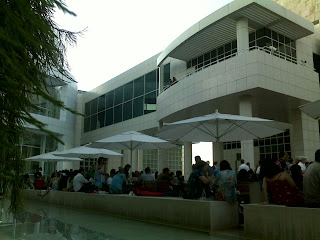
Southern California is made for the summer: Though every other season seems to be no more than a milder sequel (or prequel, depending on how you look at it), there is still a subtle change that occurs as June slides into July. The tans become more authentic, already-short hems skew ever higher, the highways become extensions of the beach parking lots, and nary a face remains unobstructed by the requisite oversize shades.
With this exodus to the outdoors, there are appropriately many opportunities for enjoying a glass or two in the summer heat - and what better way to facilitate the transition from the lingering days into warm summer nights? This Saturday, after spending an afternoon fighting the previously mentioned traffic, it was wonderful being able to spend the remainder of the Saturday outdoors at the Getty, listening to the relaxing Latin / international music from Mas Exitos while enjoying a glass of Cabernet and a hot dog. Ok, so it's not the likeliest pairing, and I can't say the Cab was particularly memorable, but the evening did not leave me wanting.
So much of what makes wine enjoyable is the context in which it's consumed, and it's tough to complain about an easy-drinking glass enjoyed al fresco in the company of good friends and while taking in such a scene. The crowd ranged from early 20s to late 30s, with many families but also groups of friends (and some awkward dates, naturally). Most people grabbed tables near the stage, or spread out picnic blankets under the trees along the shallow pool opposite the stage; my friend K commented that it felt like "a Modernist Paris-plage," with the artsy-chic//laid-back vibe and water-centric arrangement.
If you haven't had the chance to check out one of the Getty's Saturdays off the 405 (previously Fridays), make sure to drop in this summer. Some tips for visiting -
- Parking becomes a mess, so it's worth showing up early (free after 5)
- Related - Carpool!
- Pack a blanket to sit on
- & a picnic, we were envious of the amazing spreads some people had prepared
I'll be at the next one, July 25, so say hello. And in the meantime, I'll continue to fill you in on other great ways to enjoy your wine outside. Don't forget sunscreen.
--
The Getty Center
Saturdays off the 405
6 - 9 p.m.
1200 Getty Center Drive
July 25 - Cut Chemist






